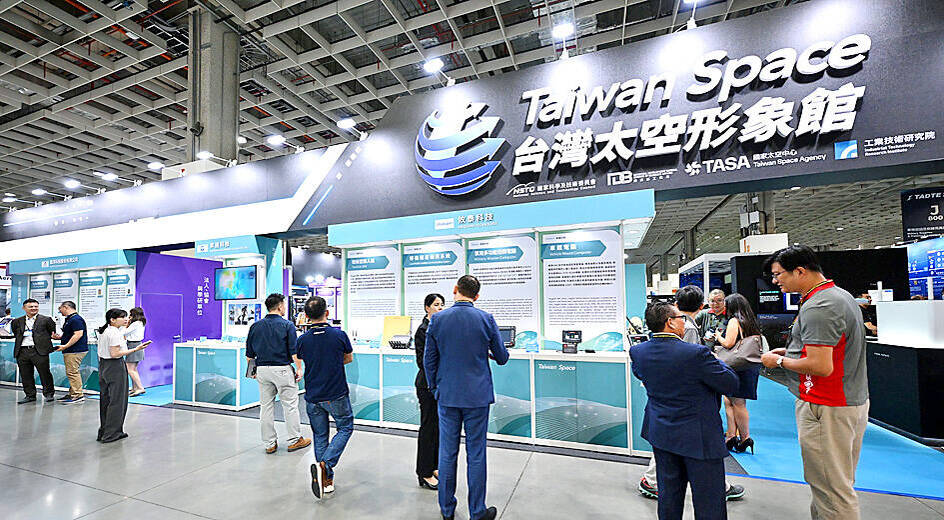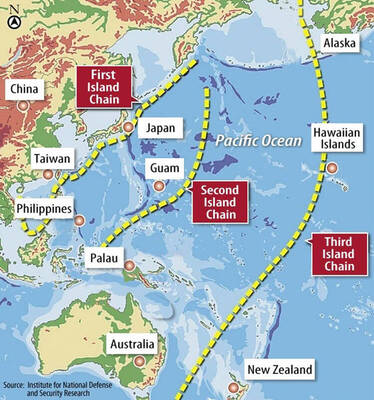The Taiwan Space Agency (TASA) plans to launch a satellite communications system similar to Space Exploration Technologies Corp’s (SpaceX) Starlink service by 2029, sources said.
TASA plans to invest about NT$2.5 billion (US$75.54 million) and work with private companies to develop four low Earth orbit communication satellites, which would communicate with each other through optical signals and connect with domestically produced 6G Non-Terrestrial Network ground equipment, they said.
Taiwan has been negotiating with international providers of satellite communications services over the past few years, but also plans to develop its own system through a public-private partnership.

Photo courtesy of the Industrial Technology Research Institute
The government had been in talks with Starlink to provide service in Taiwan, but those talks fell through due to a disagreement over ownership of a joint venture. Officials have also expressed concerns over SpaceX founder Elon Musk’s business interests in China and his past comments that Taiwan is an integral part of China.
The National Science and Technology Council had previously said it would launch six low Earth orbit satellites as part of a project it referred to as “Beyond 5G (B5G).” Toward that end, it has launched a “communications satellite manufacturing industrialization platform,” through which it would connect with local manufacturers, assisting them in satellite system design, manufacturing, integration and testing.
The Ministry of Economic Affairs has also said it would invest in the research and development of satellite systems, and has allocated a budget of NT$890 million to subsidize the satellite communications industry.
The first four low-orbit communication satellites to be launched in 2029 under B5G would operate for five years in a low orbit at an altitude of 600km to 650km, sources said, adding that the satellites would follow the technical specifications of two test satellites designed early in the project.
The satellites would be available to the industry to conduct tests of end-to-end communications performance between ground equipment and low-orbit satellites, they said.
The four new satellites would differ from the test units in their ability to conduct “inter-satellite communication handover,” they said.
“This means that when a satellite is about to leave its coverage area or cannot maintain a connection, the communication link is passed to another satellite to ensure that the connection is not interrupted,” they said, adding that the new satellites would also benefit from greater communications efficiency through inter-satellite optical communications.
“Most satellites still rely on radio frequency signals for data transmission, and need to forward signals through ground stations, affecting the overall transmission efficiency,” they said.
Inter-satellite optical communications use laser light transmitted in the vacuum of space to establish high-speed links directly between satellites, they said.
Since the frequency of laser light is much higher than that of radio signals, the bandwidth of such communications is much larger, they added.
“Laser signals are also less likely to be intercepted or interfered with by external parties, making interstellar optical communication a preferred technology of most modern satellite projects,” they said.
Sources said TASA would take bids from private companies for the manufacture of the satellites, with two companies to be selected from entries to enter the second phase of “satellite manufacturing and testing, satellite launch and on-orbit operation.”
After the launch of the four satellites, their performance would be assessed, with the control system handed over to TASA after the assessment, they said.
As the project involves national security, foreign suppliers would not be allowed to participate in the bidding, they added.

The US government has signed defense cooperation agreements with Japan and the Philippines to boost the deterrence capabilities of countries in the first island chain, a report by the National Security Bureau (NSB) showed. The main countries on the first island chain include the two nations and Taiwan. The bureau is to present the report at a meeting of the legislature’s Foreign Affairs and National Defense Committee tomorrow. The US military has deployed Typhon missile systems to Japan’s Yamaguchi Prefecture and Zambales province in the Philippines during their joint military exercises. It has also installed NMESIS anti-ship systems in Japan’s Okinawa

‘WIN-WIN’: The Philippines, and central and eastern European countries are important potential drone cooperation partners, Minister of Foreign Affairs Lin Chia-lung said Minister of Foreign Affairs Lin Chia-lung (林佳龍) in an interview published yesterday confirmed that there are joint ventures between Taiwan and Poland in the drone industry. Lin made the remark in an exclusive interview with the Chinese-language Liberty Times (the Taipei Times’ sister paper). The government-backed Taiwan Excellence Drone International Business Opportunities Alliance and the Polish Chamber of Unmanned Systems on Wednesday last week signed a memorandum of understanding in Poland to develop a “non-China” supply chain for drones and work together on key technologies. Asked if Taiwan prioritized Poland among central and eastern European countries in drone collaboration, Lin

ON ALERT: Taiwan’s partners would issue warnings if China attempted to use Interpol to target Taiwanese, and the global body has mechanisms to prevent it, an official said China has stationed two to four people specializing in Taiwan affairs at its embassies in several democratic countries to monitor and harass Taiwanese, actions that the host nations would not tolerate, National Security Bureau (NSB) Director-General Tsai Ming-yen (蔡明彥) said yesterday. Tsai made the comments at a meeting of the legislature’s Foreign Affairs and National Defense Committee, which asked him and Minister of National Defense Wellington Koo (顧立雄) to report on potential conflicts in the Taiwan Strait and military preparedness. Democratic Progressive Party (DPP) Legislator Michelle Lin (林楚茵) expressed concern that Beijing has posted personnel from China’s Taiwan Affairs Office to its

BACK TO WORK? Prosecutors said they are considering filing an appeal, while the Hsinchu City Government said it has applied for Ann Kao’s reinstatement as mayor The High Court yesterday found suspended Hsinchu mayor Ann Kao (高虹安) not guilty of embezzling assistant fees, reducing her sentence to six months in prison commutable to a fine from seven years and four months. The verdict acquitted Kao of the corruption charge, but found her guilty of causing a public official to commit document forgery. The High Prosecutors’ Office said it is reviewing the ruling and considering whether to file an appeal. The Taipei District Court in July last year sentenced Kao to seven years and four months in prison, along with a four-year deprivation of civil rights, for contravening the Anti-Corruption